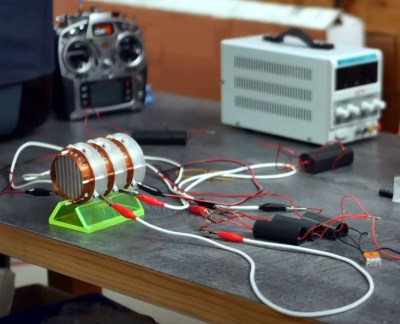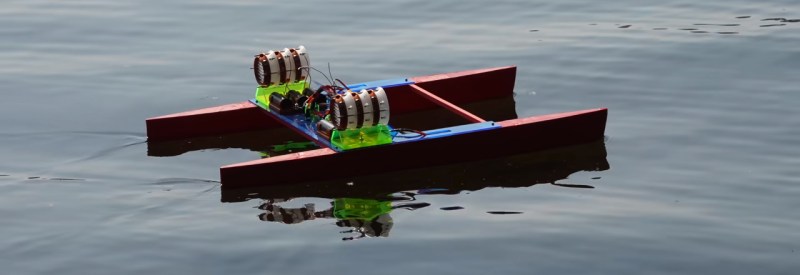Over the last several months, we’ve been enjoying a front-row seat as [Jay Bowles] of Plasma Channel has been developing and perfecting his design for a high voltage multi-stage ionic thruster. With each installment, the unit has become smaller, lighter, and more powerful. Which is important, as the ultimate goal is to power an RC aircraft with them.
There’s still plenty of work to be done before [Jay] will be able to take his creation skyward, but he’s making all the right moves. As a step towards his goal, he recently teamed up with [RcTestFlight] to attach a pair of his thrusters — which have again been further tweaked and refined since we last saw them — to a custom catamaran hull. The result is a futuristic craft that skims across the water with no moving parts and no noise…if you don’t count the occasional stray arc from the 40,000 volts screaming through its experimental thrusters, anyway.

We were particularly impressed to see the boat doesn’t use rudders, and instead relies on differential thrust between the two ion engines to turn. It was the more difficult approach to be sure, but as [Jay] explained it to us, the goal from the very start was to completely eliminate any moving components from the powertrain.
Part of that goal was undeniably for the wow factor, but it’s also key to achieving the silent operation that serves as the justification for strapping an ionic propulsion system to an otherwise standard watercraft. With no dangling bits making noise in the water, this boat could in theory be used in applications where a traditional craft might disturb wildlife. Though we suspect it might do a hell of a number on any bugs that might be flying around nearby.
It’s been fascinating to see [Jay] improve his thrusters with each new iteration, and judging by the incredible views each video has amassed, we’re not the only ones on the edge of our seats. But is it any surprise? While ionic propulsion is an established technology for spaceflight, it’s relatively unexplored as far as practical terrestrial vehicles go. With each update, it really feels like [Jay] is making progress towards something big, and we can’t wait to see what comes next.
















That is fascinating! Seems like the military might be interested in its application for craft used by special operators for covert actions of some sort.
Just speculating, but wouldn’t this leave a pretty wide trail of easily-detected ozone as well as producing a ton of EMI that’s even easier to track?
Well of course! And there isn’t anything fascinating (or new) about it too. The efect has been known for several centuries.
Only non niche practical utilization are ion thrusters on spacecrafts which are too old AF with different variants having roots in US and Sovie Union in 60s.
Plasma Channel’s implementation is very nice though of course.
It would be cool if this can produce enough thrust for a hydrofoil design to get out of the water and up on the waterfoil, because then he’d get huge reductions in drag and have something that essentially flies, but in a high density lifting medium.
Not sure these will ever produce that kind of thrust, but certainly a reduction in surface area is called for. The pontoons here have way more surface area than the need to.
Perhaps an auxiliary conventionally-powered ‘tugboat’ to get the hydrofoil up to operating speed. However, the thrusters would have to provide enough thrust to keep the body of the boat out of the water—and I doubt that they would do so. At least, not in the current configuration.
I’m impressed that it works at all, but clearly a boat poses way too much drag for it’s weight.
This thruster is nowhere near efficient at such slow speeds, too.
Maybe if it could be put on some train tracks?
TL;DW(yet), but this needs an airsoft gun so it can be a Twin Ion Engine fighter.
And solar panels. And the screaming sound.
Need to go into town to pick up a power converter…
Twin Ion Engines….
Fighter
“This prototype boat is best suited for low humidity environments” that cracked me up.
No matter how good your intentions are, if humidity is it’s enemy maybe a boat isn’t the best application.
The success of this is measured in clicks, not MPH.
wonder what happens when,say,propane is injected into the intake of an ion thruster
Every taser unit I’ve used self-destructs if you don’t allow it to spark.
Where can you get taser units that don’t self-destruct like that?
Ask and alibaba delivers. You’re looking for a ‘high voltage flyback transformer’, https://sihon.en.alibaba.com/productgrouplist-823543928/High_Voltage_Modules.html?spm=a2700.shop_plgr.98.13
Good first try. That whole thing can for sure be made a lot lighter though. Even the ion thrusters. For instance, don’t use bent metal pipes for the anode/cathode, you really just need a thin sheet of aluminium foil around a somewhat stiff form. Maybe foam like that used in RC planes would be a lot lighter.
All of the force is transmitted through the the anode and cathode, so those have to be stiff enough not to flex too badly though. Less flex also means less arcing.
The 3D printed frames could also use foaming PLA that is seeing some use in hobby RC aircraft.
Just a hunch, but a circular airflow geometry when the grid is rectilinear screams “this must be suboptimal” in my head.
Looking forward to the next iteration!
“While ionic propulsion is an established technology for spaceflight, it’s relatively unexplored as far as practical terrestrial vehicles go”
The ‘lifter’ type atmospheric ion breeze generators and vacuum-operation ion thrusters are related only by ‘ion’ being present in their name. In function, they’re about as related as a turboprop is to a pump-cycle rocket engine: both contain a turbine, but have fundamentally different modes of operation.
Maybe you could enhance the thrust by including a combustion chamber for burning (for example) propane?
Came up with an improvement that might boost air flow by about 4 times.